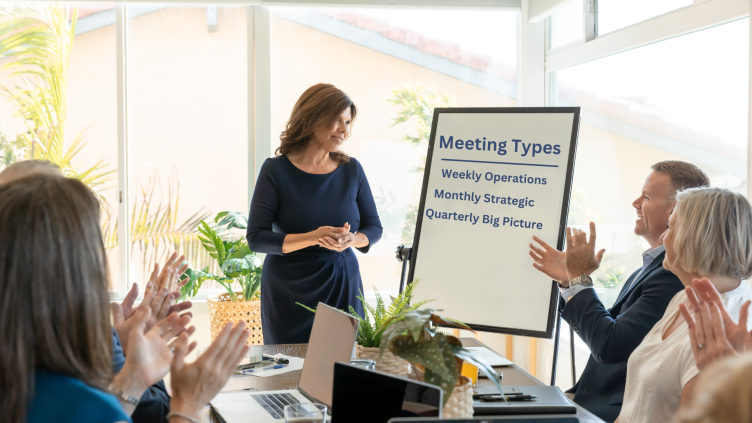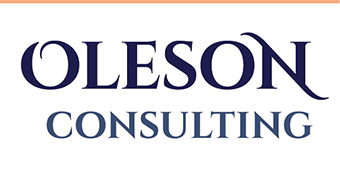Are you tired of sitting in unproductive meetings? Too many meetings with too little results?
Want to learn how to lead high-performing meetings within your team and across the organization?

High Performing Meetings – Fixing your Meetings and Gaining Results Immediately
Are you tired of sitting in too many unproductive meetings? Want to free up time and energy for solving problems and creating opportunities? Bad meetings are everywhere, but you can lead engaging meetings that produce immediate results in a few steps – for your leadership team and their teams across the organization.

I’m Margie Oleson, and I’ve dedicated the last 20 years to helping clients improve their organizations. The stark reality is that most companies I consult with have a dismal track record with their meetings – everyone complaining about too many meetings while achieving very poor results. In fact, Forbes calls poorly-run meetings an $85 billion dollar problem in the U.S.
Forbes calls poorly-run meetings an $85 billion dollar problem in the U.S.
There are three steps to leading high-performing meetings. With time and practice, you and your teams will have new habits for meeting norms and enjoy better decision-making, faster problem-solving, and freed-up time and energy for new ideas and opportunities.
Step 1 – Separate your Meeting Types. Step 1 is to identify the type of meeting. High-performing leaders host three types of meetings: The weekly operational, monthly strategic, and quarterly big picture.
· Weekly Operational. In the weekly operational meeting, you align on how things are going and what is needed to hit your targets and deadlines, serve your clients, address day-to-day process challenges and staffing needs, and more. Start with agendas, discuss, decide, and pause 5 to 10 minutes before the ending time to agree on decisions, actions, and follow-up. Most groups do not take the time to compare notes at the end of meetings, and they inevitably come away with very different views of agreements and next steps – resulting in confusion and chaos with teams essentially rowing in different directions. Implementing rigor to align during meetings helps shift the group into high performance.
· Monthly Strategic. The monthly strategic discussion tackles one or two topics in-depth – to solve problems that come up over and over again or to build capacity for new opportunities. Leaders bring the right people together who are prepared to dive deep and engage in fuller discussions that tap the collective creativity and problem-solving of the group. Imagine how distracting and inefficient it is to bring up strategic topics at an operational meeting – when the information has not been reviewed for a deeper discussion and it’s not the right people in the conversation. Separate out your tactical from your strategic conversations, and your meetings improve overnight!
· Big Picture Planning. The third type of meeting is the quarterly big picture planning conversation – time away from day-to-day issues or strategies to plan for the future. Where do you want to go? Who do you want to serve? What workforce will you need next year? This forward-looking time away complements the weekly operational and monthly strategy discussions. Then as new ideas or services are implemented, they become part of the other two meeting types. Step 1 is critical for maintaining meetings discipline by differentiating the types of meetings and focusing on the right topics at the right time.
Most companies I consult with have a dismal track record with their meetings
Step 2 – Bring the Right People Together. Step 2 ensures that the right people are assembled for the right discussions at the right time. Sometimes leaders are invited because they don’t want to miss certain meetings, or organizational politics dictate that everyone be invited to everything. Instead, high-performing meeting leaders ask who needs to provide the information and decisions for this type of meeting? When too many are invited or people are present who are not needed, they move the conversation to the areas they prefer to focus on – bringing operational challenges to the quarterly big picture conversation, for example. Or asking about new markets in the weekly operational. Having the subject matter experts and responsible leaders in the meeting for the type of meeting topics being discussed is important for leading engaging, productive meetings. Step 2 enables meeting participants to bring full value to your meetings.
Step 3 – Incorporate Meeting Effectiveness into Culture and Habits. Step 3 incorporates effective meetings into your culture and habits by tracking the quality of your meetings as intentionally as you track the quality of a service or product. When we establish the right structures and norms and monitor every meeting for what’s working and what needs to improve, bad meetings become a distant memory. My clients say they wish they had implemented better meetings earlier and would never go back to the old ways of too many meetings and too little results.
Just like my client who had been leading a global transformation program for over a year. They were stalled, not hitting their targets, and were looking at potential staffing changes – thinking performance was an issue behind poor results. I worked with them to fix their meetings, and performance turned around almost immediately. They established metrics to review how the transformation was going in the weekly operational meetings and brought issues to the strategic meetings to have time for root cause analyses and problem-solving. They also implemented my tools and processes for monitoring meeting effectiveness and team performance. Team members began to look forward to meetings and were speaking optimistically to their own teams about the potential success of the transformation.
When leadership teams shift to leading high-performing meetings, they learn to apply better meetings habits for their own teams. Soon, the organization is performing better because meetings are productive – freeing up time and space for stubborn challenges and new ideas. Are you ready to fix your meetings and gain immediate results? You can follow me on LinkedIn to learn more about high-performing meetings across your organization.
For more information, schedule a call with Margie .
Published by:
Margie Oleson, Ed.D.
Organizational Leadership and Performance. Business Consultant | Executive Coach | Top Team Accelerator | Top Team Coach | High Performance Coach | Organizational Behavior Expert and Coach



